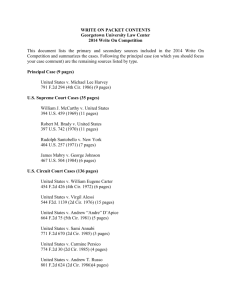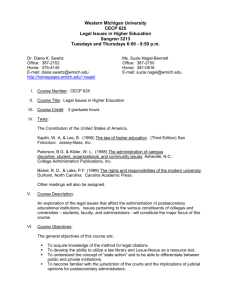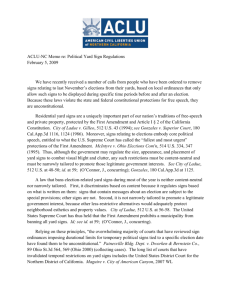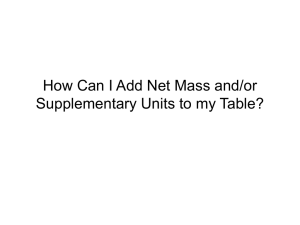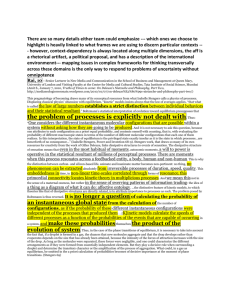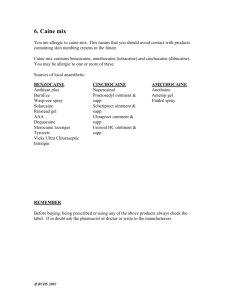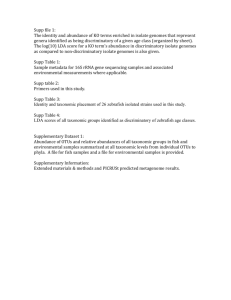Paper - International Municipal Lawyers Association
advertisement
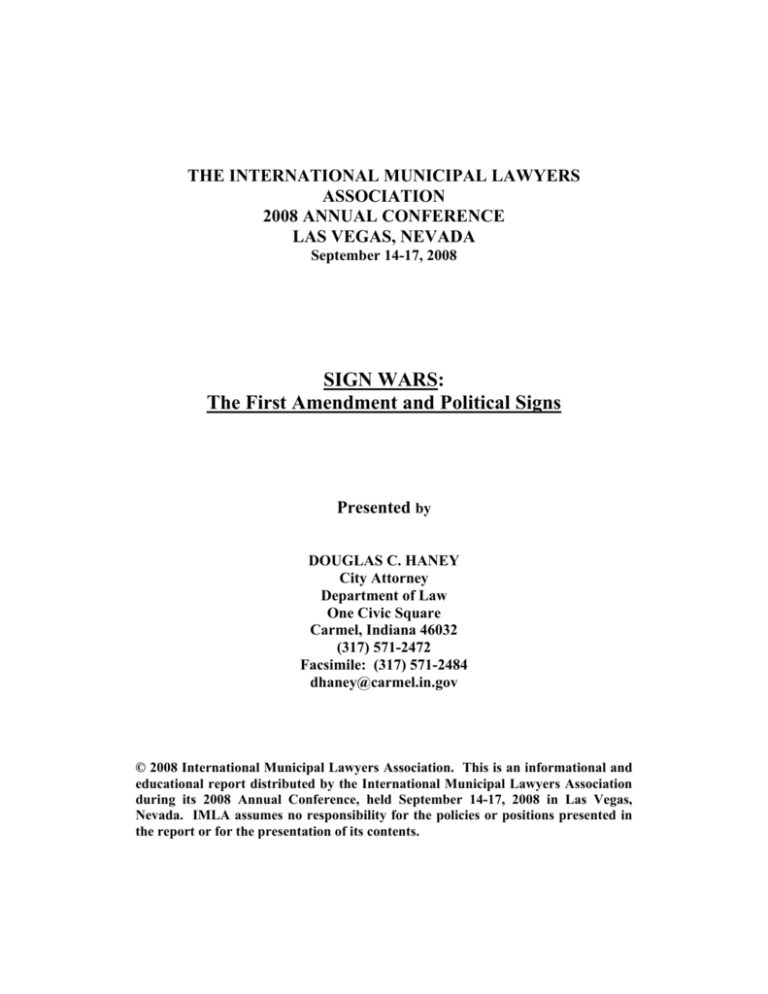
THE INTERNATIONAL MUNICIPAL LAWYERS ASSOCIATION 2008 ANNUAL CONFERENCE LAS VEGAS, NEVADA September 14-17, 2008 SIGN WARS: The First Amendment and Political Signs Presented by DOUGLAS C. HANEY City Attorney Department of Law One Civic Square Carmel, Indiana 46032 (317) 571-2472 Facsimile: (317) 571-2484 dhaney@carmel.in.gov © 2008 International Municipal Lawyers Association. This is an informational and educational report distributed by the International Municipal Lawyers Association during its 2008 Annual Conference, held September 14-17, 2008 in Las Vegas, Nevada. IMLA assumes no responsibility for the policies or positions presented in the report or for the presentation of its contents. SIGN WARS: The First Amendment And Political Signs1 I. Introduction II. Political Signs Are Protected Speech Political signs constitute protected speech under the First Amendment.2 In fact, the First Amendment has its “fullest and most complete application” to political speech.3 Political signs constitute a “decidedly unique and historical medium” that may have “no practical substitute.”4 However, they pose distinctive problems for a municipality. Signs take up space, obstruct views, distract motorists and pedestrians, displace alternative land uses, and cause other problematic secondary effects. III. Regulation of Political Signs A. Content-Based Restrictions The regulation of only political signs is the most difficult type of sign regulation to draft and defend, because content-based regulations are deemed “presumptively invalid”5 and must be able to survive a “strict scrutiny” analysis. They cannot be vague, and must be necessary to serve a “compelling state interest” and be “narrowly tailored” to achieve that end.6 1 A shorter version of this presentation was contained in the Summer 2008 newsletter of the Governmental Practice Section of the Indiana Bar Association. The author is the current Chair of that Section. 2 City of Ladue v. Gilleo, 512 U.S. 43 (1994). 3 See, e.g., Eu v. San Francisco County Democratic Central Committee, 489 U.S. 214 (1989); Meyer v. Grant, 486 U.S. 414 (1988). See also, McIntyre v. Ohio Elections Comm., 514 U.S. 334 (1995); Craig v. Boren, 429 U.S. 190 (1976); Baldwin v. Redwood City, 540 F.2d 1360 (9th Cir., 1976). 4 City of Ladue, supra., at 58. 5 See, e.g., Rosenberger v. Univ. of Virginia, 515 U.S. 819 (1995); Cincinnati v. Discovery Network, 507 U.S. 410 (1993); R.A.V. v. City of Saint Paul, 505 U.S. 377 (1992); Forsyth County v. Nationalist Movement, 505 U.S. 123 (1992); City of Renton v. Playtime Theatres, 475 U.S. 41 (1986). 6 See, e.g., McIntyre v. Ohio Elections Commission, 514 U.S. 334(1995); Austin v. Michigan Chamber of Commerce, 494 U.S. 652 (1990); Boos v. Barry, 485 U.S. 312 (1988) (plurality); Schad v. Mount Ephraim, 452 U.S. 61 (1982). See also, U.S. v. Playboy Entertainment Group, Inc., 529 U.S. 803 (2000). 1 Two (2) “traps for the unwary” to avoid are: 1. Durational Limitations Do not draft a municipal ordinance that sets a time limit on when political signs can be posted, especially if the limitation period is tied to an election date. Numerous courts have struck down such regulations, and court challenges are pending in several states.7 In Whitton v. City of Gladstone,8 the Eighth Circuit held unconstitutional a municipal ordinance which limited the posting of political signs to 30 days prior and 7 days after the date of the election to which the signs pertained. It found that the city’s justification for enacting this durational limit – to lessen traffic dangers and promote aesthetic beauty – was neither “compelling” nor “narrowly tailored” to achieve those ends. 7 See, “nytimes.com\2008\07\21\opinion\21mon4.html?ref=opinion.” Whitton v. City of Gladstone, 54 F.3d. 1400 (8th Cir., 1995). See also, Schwab v. Town of Essex, F. Supp. 2d , No. 04 Civ 1109 (CLS/RFT) (N.D. N.Y., July 21, 2005) (limitation of 30 days prior and 7 days after election invalid; Fehriback v. City of Troy, 341 F. Supp. 2d 727 (E.D. Mich., 2004) (30 day limit on display of political signs enjoined); Christensen v. City of Wheaton, 2000 W.L. 204225 (N.D. Ill., 2000) (30 day limit invalid); City of Painesville Bldg. Dept. v. Dworken & Bernstein Co., 733 N.E. 2d 1152 (Ohio 2000) (“The overwhelming majority of courts that have reviewed sign ordinances imposing duration limits for temporary political signs tied to a specific election date have found them to be unconstitutional”); Knoeffler v. Mamakating, 87 F. Supp. 2d 322 (S.D.N.Y., 2000) (durational limits on political signs are invalid); Curry v. Prince George’s County, 33 F.Supp. 2d 447 (1999) (limitation of 45 days before and 10 days after election date invalid); Taylor v. Baltimore County, F.3d , No. 98-2090, slip op. (4th Cir., July 28, 1998) (limitation of 30 days before election date enjoined); Intervine Outdoor Advertising v. Gloucester BZA, 674 A.2d 1027 (N.J., Sup. Ct. App. Div., 1996) (limit to 60 days a year invalid); Dimas v. Warren, 939 F. Supp. 554 (E.D. Mich., 1996) (limitation of 45 days before and 7 days after election date invalid); McCormack v. Township of Clinton, 872 F.Supp. 1320 (D. N.J., 1994) (limitation of 10 days prior and 3 days after election date invalid); Collier v. City of Tacoma, 854 P. 2d 1046 (Wash., 1993)(60-day pre-election date limit unconstitutional); Runyon v. Fasi, 762 F. Supp. 280 (D. Hawaii, 1991)(ordinance prohibiting outdoor signs invalid); Risner v. City of Wyoming, 383 N.W. 2d 226 (1985) (time limit on posting temporary signs invalid); Euclid v. Mabel, 484 N.E.2d 249 (Ohio Ct. App., 1984)(prohibition of political signs on residential property violated federal and state constitution); Union City BZA v. Justice Outdoor Displays, 467 S.E.2d 675 (Ga., 1984) (limit of 42 days before and 7 days after election date invalid); Antioch v. Candidates’ Outdoor Graphic Serv., 557 F. Supp 52 (N.D. Cal., 1982) (limitation of 60 days before election date invalid); Van v. Travel Info. Council, 628 P. 2d 1217 (Or., 1981)(60 day preelection date limit invalid); John Donnelly & Sons v. Campbell, 639 F.2d 6 (1st Cir., 1980), aff’d. 453 U.S. 916 (1981) (3-week limitation invalid); Orazio v. North Hempstead, 426 F. Supp. 1144 (E.D. N.Y., 1977) (No time limit on pre-election political signs is valid). But see, Waterloo v. Markham, 600 N.E. 2d 1320 (Ill. App., 1992) (90 day limitation not unconstitutional); Fisher v. City of Charleston, 425 S.E. 2d 194 (W. Va., 1992) (reasonable limitation on the posting of temporary political signs is valid); Ross v. Goshi, 351 F. Supp. 949 (D. Hawaii, 1972) (60 day limit on posting before election date is valid). 8 2 In several other cases, limitation periods of between 10 to 60 days prior and 3 to 10 days after an election date have been held invalid. Many similar cases have settled short of trial, usually with the municipality’s capitulation.9 A few courts have been more tolerant. In Messer v. City of Douglasville,10 the Eleventh Circuit approved a regulation that required political signs placed along city streets to be removed within 10 days after the election to which they applied. Finally, do not forget to check your state law. Some states limit local regulation of political signage.11 Given these obstacles, it is a rare occasion for a court to approve a content-based sign ordinance. One such case involved a content-based state statute prohibiting the display of campaign signs within 100 feet of the entrance to a polling place. In Burson v. Freedman,12 Tennessee was able to survive a strict scrutiny analysis by showing that it had a “compelling interest” in reducing voter intimidation and election fraud, and that its statute was narrowly tailored to achieve that end. 2. Favoring One Non-Commercial Message A second concern when attempting to regulate political signs is the Metromedia trap. In Metromedia v. City of San Diego,13 San Diego enacted an ordinance designed to limit the traffic distractions and aesthetic problems caused by outdoor signs. However, it prohibited only some non-commercial signs. In striking down this ordinance, the Supreme Court held that the First Amendment does not allow municipalities to distinguish 9 See, e.g., www.acluutah.org\pr102204.htm (Draper City, Utah); “washingtonpost.com\wpdyn\content\article\ 2008\4\26\AR2008042602114-P” (Botetourt, Virginia); www.mansfieldnewsjournal.com\apps]pbcs.dll\article?AID = 200880615006” (Dublin and Granville, Ohio). 10 Messer. v. City of Douglasville, 975 F.2d 1505 (11th Cir., 1992). See also, Baldwin v. Redwood City, supra.; Ross v. Goshi, supra. 11 MINN. STAT. §211B.045 (2006). See also, Texas Local Gov’t Code Sec. 216.903 (2003); Virginia Code Sec. 15.2-109 (2004). 12 Burson v. Freedman, 504 U.S. 191 (1992). See also, Grutter v. Bollinger, 539 U.S. 306 (2003); U.S. v. Grace, 461 U.S. 171 (1983). 13 Metromedia, Inc. v. City of San Diego, 453 U.S. 490 (1981). See also, GK Ltd. Travel v. City of Lake Oswego, 436 F.3d (9th Cir., 2006); Clear Channel Outdoor, Inc. v. Town Board of Windham, 352 F. Supp. 2d 297 (N.D. N.Y., 2005); Christ’s Bride Ministries v. SE Pennsylvania Trans. Auth., 148 F.3d 242 (3rd Cir., 1998); New York Magazine v. MTA, 136 F.3d 123 (2nd Cir., 1998); Rosenberger v. Univ. of Virginia, supra.; Warms v. Springfield Tshp., 1994 WL 613660 (E.D. Pa., 1994). 3 between the relative values of different categories of noncommercial speech. Likewise, in North Olmstead Chamber of Commerce v. North Olmstead,14 a federal district court struck down, on First Amendment grounds, an ordinance that restricted signs according to their type, finding this classification scheme content-based. Your sign ordinance should favor neither commercial signs nor other non-commercial signs over political signs. B. Content-Neutral Restrictions Content-neutral sign restrictions fare much better in the courts. A municipality will have little trouble showing that it has a “substantial interest”15 in using its police power to place legitimate “time, place and matter” restrictions on the posting of signs. In order to pass constitutional muster, content-neutral sign regulations must: 1. Be justified without reference to the content of the regulated signs. 2. Be narrowly tailored to serve a significant governmental interest; and 3. Leave open ample alternative channels for communicating the message set forth on the signs.16 In addressing content-neutral “time, place and manner” restrictions, it is helpful to separate political signs located on public property from such signs located on private property, since a private citizen’s interest in controlling the use of his or her own property justifies disparate treatment when it comes to signs.17 14 North Olmstead Chamber of Commerce v. City of North Olmstead, 86 F. Supp. 2d 755 (N.D. Ohio, 2000). 15 See, e.g., Ward v. Rock Against Racism, 491 U.S. 781 (1989); Newman Signs v. Hjelle, 440 U.S. 901 (1979). See also, Thomas v. City of Marietta, 265 S.E. 2d 775 (Ga., 1980). 16 FW/PBS, Inc. v. City of Dallas, 493 U.S. 215 (1990); Clark v. Community for Creative NonViolence, 468 U.S. 288 (1984); Cleveland Area Bd. Of Realtors v. City of Euclid, 88 F.3d 382 (6th Cir., 1996). 17 City Council v. Taxpayers for Vincent, 466 U.S. 789 (1984). 4 1. Public Property Turning first to public property, a municipality can prohibit the posting of all signs on public property.18 It can also prohibit the posting of signs without a permit, so long as the permitting process is content-neutral.19 The only exception is on public property that constitutes a “traditional public forum.” This would include public meeting sites and street demonstrations. As to that property only, a complete sign ban or the need for prior approval of signs, will still be subject to “strict scrutiny” as a potentially improper restraint on free speech.20 As such, except in traditional public forums, the Constitution does not prohibit content-neutral “time, place and manner” restrictions on signs posted on public property nor banning them altogether. 2. Private Property. A. Total Prohibition In City of Ladue,21 the U. S. Supreme Court invalidated a municipal ordinance that banned virtually all residential signs. It held that, by prohibiting all residential political signs, the city had impermissibly foreclosed “a venerable means of communication that is both unique and important,”22 and for which adequate substitutes do not exist. It expressed confidence that the city’s concerns about visual clutter and traffic safety could be achieved by “more temperate measures.”23 18 ld. See also, U.S. v. Kokinda, 497 U.S. 720 (1990); Herschaft v. NYC, F.Supp. , No. 02-cv0677 (E.D. N.Y., Feb. 15,2002); VFW v. City of Steamboat Springs, 195 Col. 44 (1978); City of Scottsdale v. Arizona Sign Assoc.,115 Ariz. 233 (1977). 19 See, e.g., Abel v. Town of Orangetown, 724 F. Supp. 232 (S.D. N.Y., 1989). See also, People v. Weinkselbaum, 753 N.Y.S. 2d 284 (2nd Dept., 2002). A municipality has even greater power to prohibit non-commercial speech on property it operates as a proprietor. See, e.g., Lehman v. Shaker Heights, 418 U.S. 298 (1974). 20 See, e.g., Faustin v. City and County of Denver, 268 F.3d 942 (10th Cir., 2001); Lawson v. City of Kankakee, 81 F. Supp. 930 (C.D. Ill., 2000). See also, Hague v. CIO, 307 U.S. 496, 515 (1939); City of Seattle v. Mighty Movers, 51 P.3d 152 (Wash. App., 2002). 21 City of Ladue, supra.; See also, 44 Liquormart v. Rhode Island, 517 U.S. 484 (1996); Cleveland Area Board of Realtors, supra.; Matthews v. Town of Needham, 764 F.2d 58 (1st Cir., 1985); Runyon v. Fasi, 762 F.Supp. 250 (D. Hawaii, 1991); City of Lakewood v. Colfax Unlimited, 634 P.2d 52 (Colo., 1981); Peltz v. City of South Euclid, 228 N.E. 2d 320 (Ohio, 1967). 22 Id. at 54. 23 Id. at 58. 5 Even private homeowners’ associations that act as the “functional equivalent” of a state actor face these constitutional restrictions.24 C. Limiting The Number of Signs. What little judicial trending exists on this issue suggests that municipalities cannot directly limit the number of political signs posted on a residential lot. For example, in Dimas v. City of Warren,25 the District Court for the Eastern District of Michigan struck down a municipality’s “one sign per candidate or issue” rule, finding that it “severely infringed” upon the free speech rights of those voters who lived in the same household but held different political views. Likewise, in Arlington County Republican Party v. Arlington County,26 the Fourth Circuit struck down an ordinance that limited properties to two (2) political signs per lot as being too restrictive. However, in Brayton v. City of New Brighton,27 the Minnesota Court of Appeals upheld a city ordinance that permitted one (1) opinion “or” campaign sign on private property on a year-round basis, and additional signs – up to one (1) per ballot issue and candidate – during the election season. 24 Of course, homeowner’s associations and other private common-interest community organizations may not face the same Constitutional restrictions on their ability to ban the posting of signs within their community. This is because the First and Fourteenth Amendments only affect state, not private, action. See, e.g., The Civil Rights Cases, 109 U.S. 3 (1883). Therefore, unless these private organizations can be shown to be “the functional equivalent” of state actors, they are pretty much free to ban all yard signs. See, e.g., Prune Yard Shopping Center v. Robins, 447 U.S. 74 (1980); Marsh v. Alabama, 326 U.S. 501 (1946); Hudgens v. NLRB, 424 U.S. 507 (1976); Laguna Publishing Co. v. Golden Rain Foundation of Laguna, 131 Cal. App. 3d 816 (1982). But see, Golden Gateway Center v. Golden Gateway Tenants Association, 29 P. 3d 797 (Cal., 2001); Cologne v. Westfarms Assocs., 469 A.2d 1201 (Conn., 1984). In extreme cases, the “judicial enforcement test” may also extend free speech protection to signs posted in violation of residential covenants and other contractual regulations. See, e.g., Shelley v. Kraemer, 334 U.S. 1 (1948); Gerber v. Longboat Harbour North Condominium, Inc., 757 F. Supp. 1339 (M.D. Fla., 1991); Midlake on Big Boulder Lake Condominium Association v. Cappuccio, 673 A.2d 340 (Penn. Super. Ct., 1996). Moreover, some states give greater free speech rights to their residents. See, e.g., 765 Ill. COMP. STAT. ANN. 605/18.4(h)(West, 2005); TEXAS PROPERTY CODE, Section 202.009 (2005). 25 Dimas v. City of Warren¸supra. 26 Arlington County Republican Committee v. Arlington County, 983 F.2d 587 (4th Cir., 1993). 27 Brayton v. City of New Brighton, 519 N.W. 2d 243 (Minn. Ct. App., 1994), cert. denied, 514 U.S. 1036 (1995). See also, Verrilli v. City of Concord, 548 F.2d 262 (9th Cir., 1977). 6 Perhaps limiting political signs over twenty-four (24) square inches in size to the total number of candidates and referenda on the ballot would pass Constitutional muster. One (1) Illinois appellate court, in City of Waterloo v. Markham,28 has held that requiring all temporary signs to be removed ninety (90) days after their posting is Constitutionally valid. However, municipalities will need to decide if they want to impose a durational restriction on all temporary signs posted on private property within their corporate limits. D. Sign Illumination In Whitton v. Gladstone,29 the Eighth Circuit suggested that a municipal prohibition on the external illumination of all residential signs exceeding a certain size may be a valid “time, place and manner” restriction. However, a municipality cannot single out political signs for non-illumination. Again, a municipality must decide if it wants to prohibit the illumination of all temporary signs over a certain size that are located on private property within its borders. E. What’s Left To Regulate? 1. Public Property a. You can prohibit, or place reasonable content-neutral “time, place and manner” restrictions on, all signs located on public property (except in traditional public forums). b. However, every exception to your sign restrictions makes it easier to claim that they are content-based and more difficult, since some signs that cause the same problems as restricted signs will be left unregulated.30 c. Moreover, exempting “real estate,” “construction” and other commercial signs from your sign restrictions may impermissibly favor commercial speech over more highly protected political speech.31 28 City of Waterloo v. Markham, 600 N.E. 2d 1320 (Ill. App. Ct., 1992). Whitton v. City of Gladstone, supra. See also, State v. Calabria, 693 A. 2d 949 (N.J. Super. Ct., L.D. 1997); Wallace v. Brown County Area Plan Commission, 689 N.E. 2d 491 (Ind. App., 1998). 30 See, e.g., In re Gerald Deyo, 670 A2d 793 (Vt., 1995). 31 See, e.g., Central Hudson Gas & Electric Corp. v. Public Service Comm., 447 U.S. 557 (1980); Ohralik v. Ohio State Bar Ass’n., 436 U.S. 447 (1978); National Advertising Co. v. Town of Babylon, 900 F.2d 551 (2nd Cir., 1990); Sugarman v. Village of Chester, 192 F. Supp. 2d 282 (S.D. N.Y., 2002); Savago v. Village of New Paltz, 214 F. Supp. 2d 252 (N.D. N.Y., 2002); Tauber v. Town of Longmeadow, 695 F. Supp. 1358 (D. Mass., 1988). 29 7 d. If you have to read a sign’s content to determine whether it is subject to your sign restrictions, you probably do not have a valid “time, place and manner” restriction.32 2. Private Property a. On private property, you cannot prohibit all temporary signs. b. In a content-neutral manner, (i) You can limit the size of yard signs, both individually and by total square footage. 33 (ii) You can place reasonable restrictions on the shape, height, spacing, condition and composition of temporary signs.34 (iii) You can place reasonable restrictions on the location of temporary signs, especially if they interfere with public safety.35 (iv) You may be able to place reasonable restrictions on the illumination of temporary signs. (v) You might be able to place some reasonable limitation on the duration of temporary sign postings that is not tied to election dates. (vi) You might be able to limit the number of temporary signs per lot to one (1) sign for each candidate and issue on the ballot. 32 See, e.g., Foti v. City of Menlo Park, 146 F.3d 629 (9th Cir., 1998). See, Whitton v. City of Gladstone, supra. See also, Prime Media, Inc. v. City of Brentwood, 398 F. 3d 814 (6th Cir., 2005); Valley Outdoor, Inc. v. County of Riverside, 337 F. 3d 1111 (9th Cir., 1993); Outdoor Systems, Inc. v. City of Mesa, 997 F.2d 604 (9th Cir., 1993); Baldwin v. Redwood City, supra.; Davis v. City of Green, 106 Ohio App. 3d 223 (1995) (Six square feet of signage per yard constitutional). But see, City of Hudson v. Arskinkoff, 2005-Ohio-6976, Case No. CA-22571 (Dec. 13, 2005) (Six square foot limitation unconstitutional). 34 See, e.g., Ackerley Communications v. City of Somerville, 878 F.2d 513 (1st Cir., 1989); National Advertising Co., v. City of Orange, 861 F.2d 246 (9th Cir., 1988); Candidates’ Outdoor Graffic Svc. v. San Francisco, 574 F. Supp. 1240 (N.D. Cal., 1983). 35 See, e.g., Long Island Bd. Of Realtors v. Massapequa Park, 277 F.3d 622 (2nd Cir., 2002). 33 8 IV. General Sign Ordinance Considerations Every sign ordinance should: A. Avoid sign placement being conditioned upon the un-reviewed, unlimited or discretionary approval of a municipal officer or body. B. Include a statement of the “governmental purpose” the ordinance serves, and an explanation of how it is “narrowly tailored” to meet that purpose. C. Include a recital stating that the ordinance does not, and should not be read to include, content-based restrictions. D. Include a severability clause.36 IV. Conclusion 36 See, e.g., National Advertising Co. v. Town of Babylon, supra. See also, Forsyth County v. Nationalist Movement, 505 U.S. 123 (1992); Beal v. Stern, 184 F.3d 117 (2nd Cir., 1999); Freedman v. Maryland, 380 U.S. 51 (1965); Granite State Outdoor Adver., Inc. v. City of St. Petersburg, 348 F. 3d 1278 (11th Cir., 2003); Peake Excavating Inc. v. Town Bd. Of Hancock, 93 F. 3d 68 (2d Cir., 1996). 9
